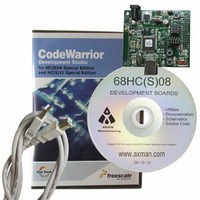DEMO9S08QD4 Freescale Semiconductor, DEMO9S08QD4 Datasheet - Page 2

DEMO9S08QD4
Manufacturer Part Number
DEMO9S08QD4
Description
BOARD DEMO FOR MC9S08QD FAMILY
Manufacturer
Freescale Semiconductor
Type
MCUr
Specifications of DEMO9S08QD4
Contents
Board, Cable, CD
Processor To Be Evaluated
MC9S08QD
Data Bus Width
8 bit
Interface Type
USB
Silicon Manufacturer
Freescale
Core Architecture
HCS08
Core Sub-architecture
HCS08
Silicon Core Number
MC9S08
Silicon Family Name
S08QD
Rohs Compliant
Yes
For Use With/related Products
MC9S08QD2, MC9S08QD4
Lead Free Status / RoHS Status
Lead free / RoHS Compliant
Stepper Motor Management
Available with this document is the software for this application note, AN3602SW.zip.
Figure 1. DEMO9S08QD4 Evaluation Board
Section 5, “How to Port the Code and Use Other
Devices,” explains the structure of the code and how it
can be ported to other similar MCUs, for example the MC9S08QG8 and the MC9S08SG8. The code
described in this application note has been developed based on the DEMO9S08QD4 evaluation board
shown in
Figure
1.
2
Stepper Motor Management
A stepper motor is a small brushless synchronous electric motor that can divide a full rotation into a large
number of steps. If this motor is electronically commutated, the motor's position can be controlled with
precision without any feedback mechanism.
Steppers exhibit more vibration than other motor types. The discrete step tends to snap the rotor from one
position to another. This vibration can cause the motor to lose torque at some speeds. The effect can be
mitigated by accelerating quickly through the problem speed range, physically dampening the system, or
using a micro-stepping driver. Motors with a greater number of phases have a smoother operation than
those with fewer phases.
There are two basic arrangements for the electromagnetic coils: bipolar and unipolar. This application note
focuses on a bipolar motor.
A bipolar motor is built with two different coils named in this document as coil A and coil B. This is why
this stepper motor has four different wires. Bipolar stepper motors operate differently from traditional DC
motors. Stepper motors have multiple toothed electromagnets arranged around a central metal gear. The
Driving a Stepper Motor Based on the MC9S08QD4 and Other 8-bit Families, Rev. 0
2
Freescale Semiconductor
















